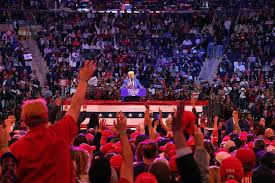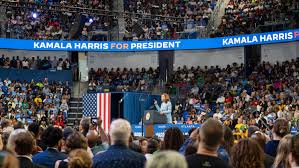As the 2024 US Presidential election looms, Kamala Harris and Donald Trump emerge as contrasting candidates, each navigating a polarized landscape shaped by mood of the electorate, gender dynamics, and crucial national issues

It’s a very interesting contest between the Vice President of the U.S., Kamala Harris, and former President Donald Trump, being races with different backgrounds each will present contrasts, different ideological processes, and styles of leadership that make it a very competitive contest with much focus on this election. In trying to predict their chances, one has to consider the mood of the American electorate, the popularity index of each candidate, and the general context of American voters’ ability to accept a female president, much more so now with Hillary Clinton’s candidature in 2016. The mood of the American electorate is the crucial determinant of this election.
The US remains highly polarized along all lines – political, social, and economic – points of contention like immigration, climate, and, more recently, the COVID-19 pandemic, after the economy and healthcare. Well, the economy, healthcare, immigration, climate, and COVID-19 pandemic issues have continued to polarize the electorate. The result is that voters are seeking a leader who can solve these burning issues and give a clear-cut vision for the future.
Kamala Harris has the special distinction of being the Vice President for this campaign. At least in that office, she had immense national visibility and experience which necessarily would come out while dealing with all national issues during the ongoing campaign. However, even with that experience, her popularity went up and down. Harris and Trump have now emerged recently in some polls tied dead where each one received 48 percent support among the registered voters. This is the first lead change from early polls, where Harris was leading Trump with a slight margin. There could be many reasons behind her decline. Above all, there must be enough emotions attached to her connection with the incumbent regime and apprehensions about her failure to make a difference.

But Donald Trump is a polarizing figure. Though his presidency has been highly controversial and has an ongoing series of legal challenges, he is still holding on to a sturdy base of support. His rating seems stable since many in the electorate feel positively about his first term. The mobilization of that base would be much easier for him than attempting to mobilize voters disillusioned with the current administration because Trump has a comfortable margin now. Of course, the speech he makes also carries divisive rhetoric and past controversies that alienate a large portion of the electorate.
The popularity index of each candidate further gives a deeper insight into the prospects of each candidate. Kamala Harris’s favorability ratings, on the other hand, have lessened as given by recent polls set at 43% positive ratings and 49% negative ratings. This shift in the sentiment of the voter reflects the hurdles that she has encountered in her efforts toward achieving broad-based support for her candidacy. For instance, even once-core groups, including independents and the younger generation, have started to weaken. On the other hand, the favorability rating for Trump has stabilized, while most of the electorate perceives him as unfavourable. However, his having a loyal constituency remains impossible to discount.
Gender factor
The other critical aspect of this election is how the electorate has accepted an American female president. This is because Hillary Clinton’s 2016 election presents lessons that must be taken seriously in this area. Clinton won the popular vote, but she had to face countless criticism obstacles. Among them were her gender bias and lack of electability. Pragmatic bias is estimated to include the perception that others were not ready to choose a woman for the presidency, another reason behind Clinton’s failure. This factor is current and will continue ruling over preferences among voters because most people in America are sceptical regarding the idea of electing women.
Kamala Harris also faces the same challenges. Though increasingly, female leaders are more welcomed in their societies, gender discrimination is an important benchmark. In a recent study, it was found that 76% believed that for a woman to defeat a male candidate would be tougher. To this is added the perception that female candidates have to surpass two yardsticks: the stature of the candidate and the extent of their criticism. But such challenges still, there is some indication of shifting opinions. A survey conducted among young voters in swing states found that 68 percent felt America was ready for a female president. This shift of opinion in more youthful voters may be a decisive factor in the Harris campaign.
It is a very complex phenomenon if one goes deeper into American voters’ acceptability of a female president. While there is a growing realization of women’s abilities and leadership qualities, deep-seated biases and stereotypes are quite prevalent. These are often encouraged by media coverage and societal beliefs that make it difficult for a woman candidate to find wide acceptability. However, the increased mileage that women have been gaining within all sectors of governance is slowly changing these perceptions. Kamala Harris represents one of the most important steps toward that transformation, but only long-term efforts and overall societal transformation will overcome those prejudices.
Campaign strategy
As the presidential campaign garners momentum in the run-up to the finale on November 5, Kamala Harris and Donald Trump are in the middle of shifting political cultures. In this respect, Kamala Harris would have to establish a sense of distance from the present administration that should underpin all of her accomplishments and vision for the future. She must articulate her portfolio of policy ideas clearly and show that she is a leader who can navigate the US out of its messes: economic recovery, healthcare reform, climate change, and so on. Grassroots campaign infrastructure, outreach to and coordination with grassroots organizations, and a robust digital footprint will all be crucial components in enabling her messages to reach as many different, disparate factions of voters as possible.
Donald Trump is probably focusing on expanding his base and exploiting the desperation created among the voters who have been left behind by this administration. His strategy in the campaign is probably somewhat similar to some of what he did before, be it the same as the previous tax cuts and deregulation, as well as the way the incumbent administration handled matters of significant importance. He is playing off the interests of the media, but he is also bringing into the campaign his masterful use of social media to mobilize his cause. However, he will also face the controversy and court battles that trailed him out of office.
Now, it is going to be independent and swing voters who will significantly have a role in deciding the outcome of the election. Frequently, they do not lean too far either on one side or the other, more precisely, a major party. And with close races, they usually played the defining role. So, both Harris and Trump are going to need to appeal to them by giving their talk and showcasing a tremendous vision for the future. This would speak to Harris as an emphasis on bipartisanism and pragmatic solutions, whereas Trump will rely on his outsider status and the promise of upheaving the political establishment.
Factors beyond its control will also determine the outcome of the elections, including how the economy will perform and other global events. Media is such a significant tool in this perception level and also on the level of voting behaviour; therefore, it cannot be played down. Probably media scrutiny awaits Harris to ensure that her message gets through. Campaign financing and political advertising have become the most expensive. Both candidates will require enormous sums of money to fund the campaign which includes advertisement as well as outreach and mobilization. Their ability to raise funds and strategically use them to build a campaign infrastructure will determine what approach is best used to reach the voters across the board.
Wider aspects of the USA’s cultural and social dynamics also come into play. For example, race and gender equality, immigration, and social justice issues are the centrepieces of the Harris campaign. Her candidacy brings to America a historic chance toward better representation and diversity but it is, at the same time, living proof of the durable issue of full equality. Perhaps, Trump’s campaign is simply strong enough to reach out to people who are threatened by social change and such type of traditional values.
The Way ahead
The poll will depend on the collective play of the strategic decisions by the candidatures, voter behaviour, events, and social trends. Both Kamala Harris and Donald Trump carry forward the asset and liability in their bid to capture the presidency; the determinant factor for success or failure will lie with voter connection, a clear vision for public expression, and how they navigate the complexities of the general political landscape.
These prospects, then, are shaped by a wholeness of considerations and encompass the mood of the American electorate, their popularity indices, and the broader perspective of gender bias in politics. Harris’s association with the current administration, besides fluctuating popularity, stands as a challenge. On the other hand, Trump’s stable base of support and polarizing persona add a layer of complexity to the race. The notion of a female president continues to be a matter of utmost controversy, and Harris is to face the same kind of bias that Hillary Clinton’s campaign has faced.
As the election draws near, both candidates have to navigate these waters and emerge as a winner. Ideally, it will also decide not only who the next president will be but also carry the reflection of the larger attitude of society pertaining to leadership and gender equality in America. It follows that voters need to be highly enlightened, should participate in this great democratic process, and critically examine the platforms and credentials of persons vying for office in the elections. The nature of the elections is of such a kind that the stakes are very high as the choices made will find reverberations into the future of the United States of America and by extension, the world. By participating in the electoral process, for instance, citizens can influence their own leaders to institute more justice and equality.
(The author is currently in Washington, D.C.and Editor of ‘STAR Views’)













